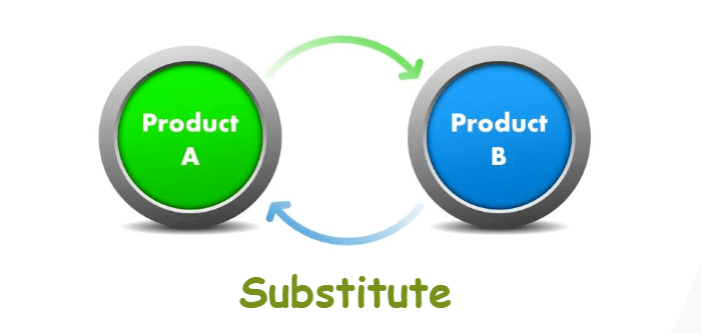SubstituteWhat is a Substitute?In economics, a product or service that customers perceive to be substantially the same as or sufficiently similar to another product is referred to as a substitute or substitutable good. In simple terms, a product that serves as a replacement is known as a substitute. 
In the marketplace, substitutes are significant and seen favourably by customers. They give consumers additional or alternate options, which improve their ability to meet their requirements. Bills of materials frequently include substitute parts that, if the primary part is damaged, can replace the primary part(s). Understanding SubstitutesSubstitutes give consumers options when they are making purchases of certain things. Substitutes occur when there are at least two things that can serve the same function, for instance, an IOS vs an Android phone. A product must have a certain relationship or similar functionalities to another item in order to serve as a substitute for that product. These connections might be direct-like one brand of tea and another-or indirect-like coffee and tea. Giving customers additional options encourages market competition, which usually drives down the prices of respective items. While that would benefit customers, it might have the reverse effect on business profits. Substitute products might reduce a company's profitability or witness a decline in market share because consumers might favour one over another. If the price of a product increases, the demand for an alternative will typically increase, according to the relationship between the demand and delivery schedules of substitute goods. This is because consumers will pick the cheaper alternative over the more expensive one. For instance, if coffee prices rise, people may move from coffee to tea to save money, which would raise the demand for tea. On the other hand, if a good's price drops, so might the demand for its equivalent. If demand for Y rises when the price of X rises or if there is a positive cross-elasticity of demand, then, in economic terms, X and Y are substitutes. Examples of Substitute ProductsAlternative or substitute products are all over the place. As already mentioned, they frequently provide the same function or typically meet identical demands of customers' requirements. Listed below are a few instances of substitute goods:
One thing to note about substitutes is that they can, and frequently will vary in how much one good can be used in place of another. Perfect and Imperfect Substitutes
A service or product may not always be easily categorised as a substitute. The level to which certain goods or services can be considered substitutes differs. If a substitute fully or only partially satisfies the needs of the customers, it determines whether it is perfect or imperfect. A perfect substitute could be utilised in the same manner the product or service it replaces was intended to be used. Here, the product's or service's utility is essentially the same. One dollar bills, for instance, can be used in place of other $1 bills. Additionally, butter from 2 distinct producers is also regarded as an ideal substitute because, although having a different producer, both types of butter serve the same functions. Even though they are hardly perfect alternatives, a bike and a car can be used to travel from point A to b. The demand schedule also exhibits certain quantifiable relationships. Even if an imperfect substitute could be replaceable, customers might be able to tell there is a difference to some extent. Consequently, some customers could decide to remain with one product over another. Suppose we compare Coke and Pepsi. Even if Coke's price increases, some customers might still pick Coke over Pepsi-possibly due to taste or brand. Even though some people believe Pepsi and Coke are ideal substitutes, if consumers discern between the two beverage brands, they may view Pepsi as an imperfect alternative to Coke. Less-perfect substitutes are sometimes categorised as net or gross substitutes, especially when considering utility. When the demand for X rises as the price of Y does, this is known as a gross substitute. Net substitutes are those in which the utility obtained from the substitute is unchanged while the demand for X rises as the price of Y rises. Substitute Goods in Monopolistic and Perfect CompetitionIn situations of perfect competition, perfect substitutes are occasionally thought of as nearly identical products offered by various businesses. For instance, the petrol sold by one petrol station in one location and the petrol sold by some other petrol station in the other location may be nearly identical. More individuals will select the less expensive alternative if the price rises at one station. Monopolistic competition is an intriguing example of how the idea of substitutes can be complicated. Companies under monopolistic competition are not price-takers, which means that demand is not very price-sensitive. A typical illustration is a distinction between name-brand and store-brand medications at a nearby pharmacy. Chemically, the goods are practically identical, but because of the benefits customers may get-or think they get-from choosing a brand-name medication over a generic one because they consider it to be more reputable or of greater quality, they are not considered perfect substitutes. Effects of Substitute ProductsChallenging Pricing Atmosphere Because every manufacturer of the alternative product is attempting to increase sales, the main factors they can count on include branding and pricing. As a result, the pricing of goods with multiple replacements is highly variable. Profits are more likely to be earned in a market when fewer substitute goods exist. Access to a Large Selection of Products Having more products available can result in higher utility. No one product can meet the needs of every customer of a certain category. Therefore, the likelihood that each buyer will find the perfect substitute increases as the number of alternatives increases. High Level of Competition The more alternative products there are on the marketplace, the more competition there is in the sector. Low-Quality Goods Companies attempt to employ the fewest resources in their production process to minimise costs in order to be the lowest seller on the market. However, as it occasionally results in the manufacture of subpar goods, this works against the customer's welfare. Factors Increasing the Risk of Substitute ProductsThe Price of the Goods If two products are priced similarly, as with writing pens, customers are more likely to switch from one pen to another unless they're loyal to a specific brand they have been using. Low Switching Costs The loss or additional expense one pays while switching from one option to another is known as the switching cost. For instance, if one has been taking notes with a pen and now wishes to use a laptop for writing documents, the cost of switching, in this case, is considerable because one will need to acquire the laptop while another one will still, probably continue to use a notebook and a different pen. Also, switching between pens is easier because doing so doesn't usually cost higher. Availability of the Substitute Item Customers may switch brands more frequently if alternatives are easily accessible in all market segments. Quality of the Goods Consumers are more likely to shift to a product that provides higher quality if alternatives are extremely distinctive and of excellent quality. For instance, consumers of cosmetics like skin brightening creams are quite picky about quality. When people learn there is a better alternative on the marketplace, they will stop using the current product. Product Performance The client will select the best alternative for the specific situation if the two alternatives perform differently under varied situations. For instance, in the transportation industry, most individuals choose small vehicles while commuting over shorter distances. However, commuters may choose large buses and trains over large distances. The preference may result from various factors, although comfort may be the primary. Why do customers choose Alternatives?There are many reasons why consumers may choose substitutes or alternatives. Let's look at a few of them below: Price Probably the most typical factor leading consumers to choose different products is price. If a glass of drink costs $10 in a restaurant and a coke costs $3, the client must think the drink is worth $7 more. However, every person assigns a different value to every product. Therefore, the buyer chooses based on their preference for one thing over another. These are choices one would make without giving them much thought. Quantity Supply and quantity frequently have an impact on consumers' choices to buy alternative goods. For instance, the last remaining muffins might have been sold at the nearby supermarket. So, the customers might search for alternatives in the local market instead. Quality The demand for alternatives to the product might be impacted by its quality. During the decision-making process, it can be considered if a well-known item doesn't taste as well, last long, or be as comfy. There might be that run-down eatery around the corner with decent meals. However, the lesser quality is taken into consideration along with the cost. Geography There could be two grocery stores. There are two, one on the way from home to the office and the other about 15 minutes away. The consumer benefits from the location's convenience accordingly, saving their time. This is another element that the purchaser will think about while choosing a product. Tastes Consumer preferences might vary over time. A trend or seasonal item might only be offered at particular seasons of the year. Some food items, for instance, are exclusively offered during the festive season. Although it may be used in place of other food items, the product's seasonality adds value for the consumer. Income Increases in income can influence consumer behaviour on a micro level. Customers can purchase coffee at a restaurant rather than make their own. Alternatively, when their incomes rise, they may purchase more branded products. When comparing replacement goods, the price of a product becomes less important as earnings rise. |
 For Videos Join Our Youtube Channel: Join Now
For Videos Join Our Youtube Channel: Join Now
Feedback
- Send your Feedback to [email protected]
Help Others, Please Share










